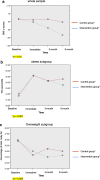Family-based intervention using face-to-face sessions and social media to improve Malay primary school children's adiposity: a randomized controlled field trial of the Malaysian REDUCE programme
- PMID: 30071855
- PMCID: PMC6090983
- DOI: 10.1186/s12937-018-0379-1
Family-based intervention using face-to-face sessions and social media to improve Malay primary school children's adiposity: a randomized controlled field trial of the Malaysian REDUCE programme
Abstract
Background: Social media may be an effective medium by which parents could be trained to promote healthy eating behaviour and physical activity for their children. This trial evaluates the effectiveness of a family-based intervention using social media in combination with face-to-face sessions - the REDUCE (REorganise Diet, Unnecessary sCreen time and Exercise) programme - on adiposity of Malay children.
Methods: Five primary schools in an urban area in Selangor, Malaysia participated in this two-arm randomized controlled field trial. Participants were parents (n = 134) and their primary school-going children 8-11 years of age who were either overweight or obese. These parent-child dyads were randomly allocated to intervention and wait-list control groups and were blinded to group assignment. The intervention was a four-week training programme using two face-to-face sessions and two Facebook sessions followed by weekly booster sessions over a three-month period using WhatsApp. The primary outcome was body mass index (BMI) z-score. Height, body weight, waist circumference and percentage of body fat were measured by blinded assessors. Data were collected at baseline (T1), immediately post-training (T2) and at three- (T3) and six-month post training (T4) and were analysed using generalized linear mixed modelling adjusted for covariates to estimate the intervention effects. Subgroup analysis was conducted for overweight and obese children.
Results: Ninety-one percent of parents completed the study, 64 in intervention group and 58 in wait-list group. At the sixth month post-training, BMI z-scores were significantly reduced in the intervention group compared to the wait-list group, for the all children (overweight and obese children) and within the obese subgroup ((F(6, 517) = 2.817, p = 0.010) and (F(6, 297) = 6.072, p < 0.001) respectively. For waist circumference percentile and body fat percentage, the intervention group experienced a significant reduction compared to the wait-list group, within the obese subgroup ((F(6, 297) = 3.998, p = 0.001) and within the overweight subgroup (F(6, 201) = 2.526, p = 0.022).
Conclusions: The four-month REDUCE intervention programme was effective in reducing childhood adiposity. Further research using this approach needs to be conducted including cost-effectiveness studies before implementing it in a child obesity prevention programme.
Trial registration: Australian New Zealand Clinical Trials Registry: ACTRN12617000844347 (7 June 2017 retrospectively registered). National Medical Research Register, Ministry of Health Malaysia: NMRR-14-685-21,874 (July 2014).
Keywords: Body fat percentage; Body mass index; Paediatric obesity; Parents intervention; Primary school children; Social media; Waist circumference.
Conflict of interest statement
This study was approved by the Medical Research Ethics Committee for Human Research, Universiti Putra Malaysia (Ref: UPM/TNCPI/RMC/1.4.18.1 (JKEUPM)/F2). Approvals were also received from Ministry of Education, State Education Office, District Education Office and Headmaster of each school. All parents were given the respondents’ information and consent forms that clearly explained the study prior to recruitment. Parents also provided consent on behalf of their children to participate in this study.
Not applicable.
The authors declare that they have no competing interests.
Springer Nature remains neutral with regard to jurisdictional claims in published maps and institutional affiliations.
Figures
References
-
- World Heath Organization. New global estimates of child and adolescent obesity released on World Obesity Day. 2017. Available from: http://www.who.int/end-childhood-obesity/news/new-estimate-child-adolesc.... Accessed 17 Oct 2017.
-
- Ng M, Fleming T, Robinson M, Thomson B, Graetz N, Margono C, et al. Global, regional, and national prevalence of overweight and obesity in children and adults during 1980-2013: a systematic analysis for the global burden of disease study 2013. Lancet. 2014;384(9945):766–781. doi: 10.1016/S0140-6736(14)60460-8. - DOI - PMC - PubMed
-
- Institute of Public Health Malaysia. National Health and Morbidity Survey 2011. Non communicable diseases. Volume II. Institute of Public Health Malaysia. 2011. 192 p. Available from: http://www.iku.gov.my/images/IKU/AQ9Document/REPORT/NHMS2011-VolumeII.pdf. Accessed 21 Nov 2013.
-
- Institute of Public Health Malaysia. National Health & Morbidity Survey 2015. Non-communicable diseases, risk factors & other health problems. [Internet]. Kuala Lumpur: Institute of Public Health Malaysia; 2015. Available from: http://www.iku.gov.my/images/IKU/Document/REPORT/nhmsreport2015vol2.pdf. Accessed 20 Apr 2016.
-
- World Health Organization. Obesity and overweight [Internet]. Geneva: World Health Organization; 2018. Available from: http://www.who.int/news-room/fact-sheets/detail/obesity-and-overweight. Accessed 20 July 2018.
Publication types
MeSH terms
Grants and funding
LinkOut - more resources
Full Text Sources
Other Literature Sources
Medical



